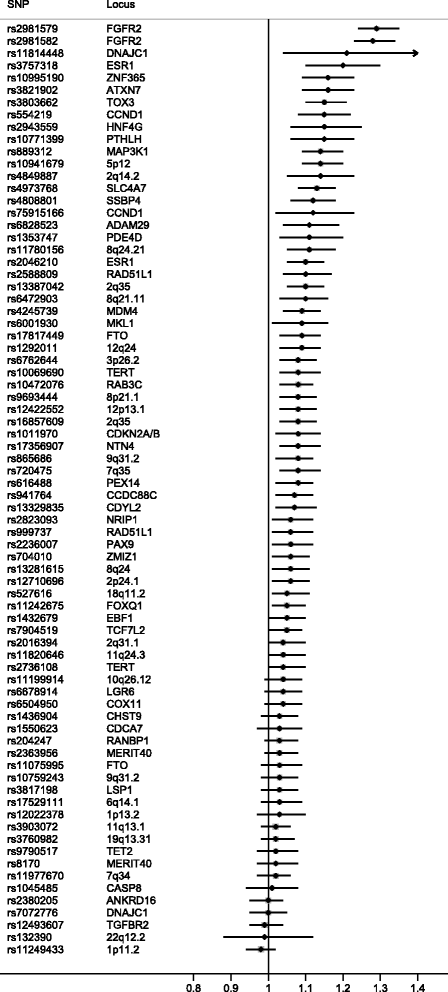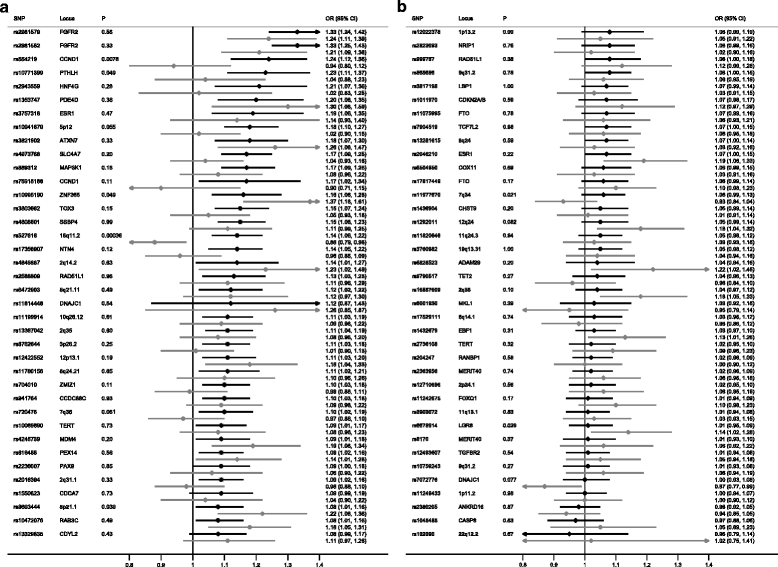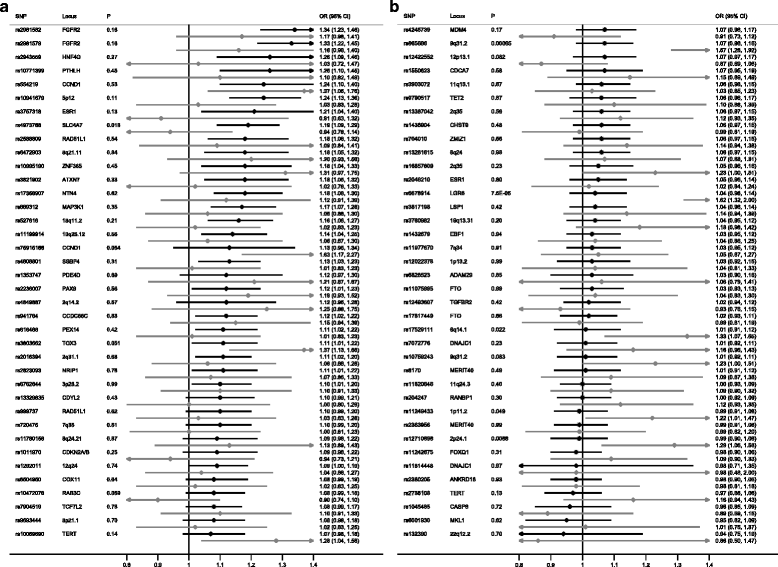Genetic predisposition to ductal carcinoma in situ of the breast
- PMID: 26884359
- PMCID: PMC4756509
- DOI: 10.1186/s13058-016-0675-7
Genetic predisposition to ductal carcinoma in situ of the breast
Abstract
Background: Ductal carcinoma in situ (DCIS) is a non-invasive form of breast cancer. It is often associated with invasive ductal carcinoma (IDC), and is considered to be a non-obligate precursor of IDC. It is not clear to what extent these two forms of cancer share low-risk susceptibility loci, or whether there are differences in the strength of association for shared loci.
Methods: To identify genetic polymorphisms that predispose to DCIS, we pooled data from 38 studies comprising 5,067 cases of DCIS, 24,584 cases of IDC and 37,467 controls, all genotyped using the iCOGS chip.
Results: Most (67 %) of the 76 known breast cancer predisposition loci showed an association with DCIS in the same direction as previously reported for invasive breast cancer. Case-only analysis showed no evidence for differences between associations for IDC and DCIS after considering multiple testing. Analysis by estrogen receptor (ER) status confirmed that loci associated with ER positive IDC were also associated with ER positive DCIS. Analysis of DCIS by grade suggested that two independent SNPs at 11q13.3 near CCND1 were specific to low/intermediate grade DCIS (rs75915166, rs554219). These associations with grade remained after adjusting for ER status and were also found in IDC. We found no novel DCIS-specific loci at a genome wide significance level of P < 5.0x10(-8).
Conclusion: In conclusion, this study provides the strongest evidence to date of a shared genetic susceptibility for IDC and DCIS. Studies with larger numbers of DCIS are needed to determine if IDC or DCIS specific loci exist.
Figures



Comment in
-
Common genetic susceptibility to DCIS and invasive ductal carcinoma.Breast Cancer Res. 2016 Jun 10;18(1):60. doi: 10.1186/s13058-016-0719-z. Breast Cancer Res. 2016. PMID: 27286830 Free PMC article. No abstract available.
References
-
- Ruszczyk M, Zirpoli G, Kumar S, Bandera EV, Bovbjerg DH, Jandorf L, et al. Breast cancer risk factor associations differ for pure versus invasive carcinoma with an in situ component in case-control and case-case analyses. Cancer Causes Control. http://dx.doi.org/10.1007/s10552-015-0696-z. - DOI - PMC - PubMed
Publication types
MeSH terms
Substances
Grants and funding
- CA54281/CA/NCI NIH HHS/United States
- CA128978/CA/NCI NIH HHS/United States
- R01 CA176785/CA/NCI NIH HHS/United States
- P30 CA016056/CA/NCI NIH HHS/United States
- UM1 CA164920/CA/NCI NIH HHS/United States
- 16565/CRUK_/Cancer Research UK/United Kingdom
- C12292/A11174/CRUK_/Cancer Research UK/United Kingdom
- C5047/A10692/CRUK_/Cancer Research UK/United Kingdom
- R01 CA128978/CA/NCI NIH HHS/United States
- P50 CA116201/CA/NCI NIH HHS/United States
- C5047/A15007/CRUK_/Cancer Research UK/United Kingdom
- R01 CA132839/CA/NCI NIH HHS/United States
- C1281/A12014/CRUK_/Cancer Research UK/United Kingdom
- CA098758/CA/NCI NIH HHS/United States
- C8197/A16565/CRUK_/Cancer Research UK/United Kingdom
- MC_PC_14105/MRC_/Medical Research Council/United Kingdom
- CA116201/CA/NCI NIH HHS/United States
- P30 CA016056-32/CA/NCI NIH HHS/United States
- CAPMC/ CIHR/Canada
- CA63464/CA/NCI NIH HHS/United States
- C490/A10124/CRUK_/Cancer Research UK/United Kingdom
- U01 CA116167/CA/NCI NIH HHS/United States
- C5047/A8384/CRUK_/Cancer Research UK/United Kingdom
- C1287/A 10710/CRUK_/Cancer Research UK/United Kingdom
- CA116167/CA/NCI NIH HHS/United States
- CA176785/CA/NCI NIH HHS/United States
- U19 CA148537/CA/NCI NIH HHS/United States
- R01 CA116167/CA/NCI NIH HHS/United States
- C1287/A12014/CRUK_/Cancer Research UK/United Kingdom
- R01 CA063464/CA/NCI NIH HHS/United States
- 16563/CRUK_/Cancer Research UK/United Kingdom
- R01 CA054281/CA/NCI NIH HHS/United States
- U01 CA063464/CA/NCI NIH HHS/United States
- 090532/Z/09/Z/WT_/Wellcome Trust/United Kingdom
- U19 CA148112/CA/NCI NIH HHS/United States
- U01 CA098758/CA/NCI NIH HHS/United States
- CA132839/CA/NCI NIH HHS/United States
- U19 CA148065/CA/NCI NIH HHS/United States
- 10119/CRUK_/Cancer Research UK/United Kingdom
- WT_/Wellcome Trust/United Kingdom
- C1287/A10118/CRUK_/Cancer Research UK/United Kingdom
- U01 CA164973/CA/NCI NIH HHS/United States
- R37 CA054281/CA/NCI NIH HHS/United States
- 16561/CRUK_/Cancer Research UK/United Kingdom
- 10124/CRUK_/Cancer Research UK/United Kingdom
LinkOut - more resources
Full Text Sources
Other Literature Sources
Medical
Molecular Biology Databases
Research Materials

